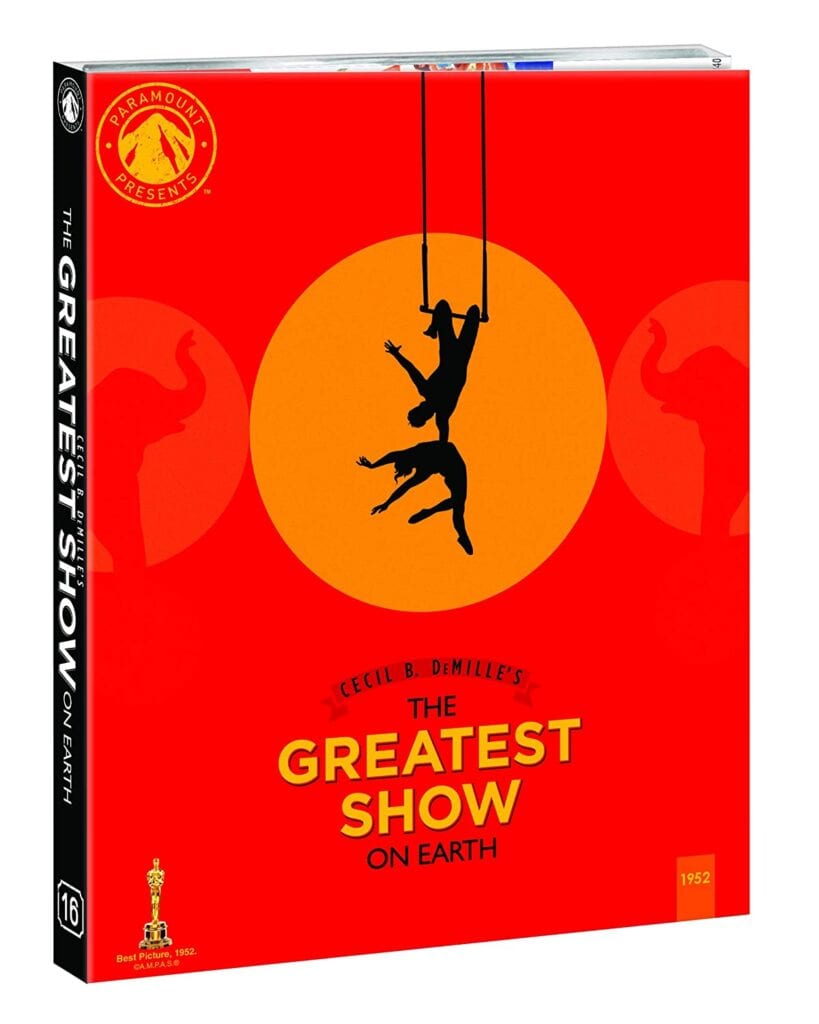
Epic corn was director Cecil B. DeMille’s metier, and The Greatest Show on Earth (1952; 152 minutes), his circus opus which won the Best Picture Oscar, is a veritable cornfield. I enjoyed the movie when I was a kid; and it still offers much in the way of an old-time wingding, but it’s lame and (for me, anyway) a surefire means by which to catch some zees with the TV on.
DeMille is an easy target. Having honed his trade during the silent era of film—and having gained a reputation for the overwrought spectacle (no better exemplified than in his hokey confections of the biblical bent: Samson and Delilah, The Ten Commandments [the 1956 version])—he was well on his way to becoming a trusted brand name by the time he poured all kinds of Paramount money into The Greatest Show on Earth. And he lards it with DeMille hallmarks: the quasi-profound voice-over; the sheer emphasis on, and drive toward, bigger-is-better; the simple and sudsy melodramatics; and the crowd shots that teem with large masses of animals and people—they’re all here, and (because of the stylistic and technological innovations that have come out since) the overall effect isn’t awe-inducing today so much as it bears a certain stately panache.
Part of the film’s draw is its documentary value-add. In many of the scenes under the big tent, (or when we watch the crew pitch it), we are witness to the actual (and now defunct) Ringling Bros. and Barnum & Bailey Circus doing their thing with the various movie stars woven into the action. The suspenseful aerial stunts; the endless, stale musical parades; and the cute elephants (infants on up) are mostly real, with no cost spared to capture them in loud Technicolor. The movie plays like an extended news reel would—but while it intersperses the drama between the characters, it suffers without a shorter running time that might have kept things bouncing along.
All the fake behind-the-scenes action centers on Brad Braden (Charlton Heston), boss of the circus, and his efforts to keep the whole enterprise in the black while a pretty boy trapeze artist, the Great Sebastian (Cornel Wilde), makes a pass at every female in the show, including Angel (Gloria Grahame), an elephant rider, and the other trapeze star, Holly (Betty Hutton, who did several of her own stunts). Holly is Brad’s girl, but finds Sebastian’s charms, and his go-for-broke daring, hard to resist. As if keeping these egos in check was not enough: Brad must also deal with a beloved clown, Buttons (James Stewart), who is always in clown-face and may be on the lam.
All of this plays out predictably enough. And some of it is fun. (I got a kick out of the banter between Grahame and Heston, when she boldly tends to him in his portable office—one of the few times we get an inside peek at what I imagine a more rascally and therefore, I suspect, authentic slice of circus life was like.) There is even an amusing cameo by a couple of unbilled movie stars (look fast or it’ll skip right past you). As Buttons, Stewart makes the sharpest impact among the leads—would that DeMille and team had gone darker with his character, but alas—this was big-budget family viewing for the mid-1950s. If nothing else in the film has aged well, at least a superbly shot and edited, climactic train crash still packs a punch (using miniatures, no less).
Had DeMille dosed the rest of The Greatest Show on Earth with that level of excitement and urgency, it might have endured as a tame film that folks return to, a candy-colored souvenir of a semi-forgotten pastime (fancy Vegas shtick aside, the modern Cirque du Soleil isn’t the barnstorming, train-trotting experience the American circus used to be). Shoot, had DeMille injected that same darkness and swiftness into the rest of the story, the movie would have been a movie.
But in this show, the corniest one on Earth, paint dries faster than an elephant struts.
The limited-edition Paramount Blu-ray, out today, looks and sounds great, and has an interview with esteemed film historian Leonard Maltin, who talks about the movie’s production. The Blu-ray also has a cool foldout image of the film’s theatrical poster and an interior spread with key movie moments.
1 Comments
Leave a Comment
You must be logged in to post a comment.
When I finally saw this, early this century, I was underwhelmed aside from the train crash.